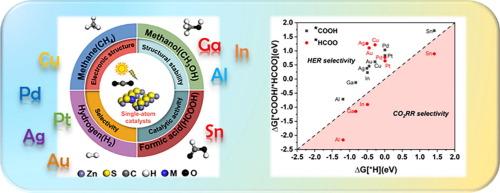First-principle study on the conversion of CO2 to value-added C1 products using single-atom cocatalysts on ZnS
IF 6.9
2区 材料科学
Q2 CHEMISTRY, PHYSICAL
引用次数: 0
Abstract
Photocatalytic CO2 reduction reaction (CO2RR) offers a sustainable solution to alleviate the greenhouse effect, and produce various chemical products and fuels. This study investigated the structural stability, electronic structure, catalytic activity, and selectivity of M/ZnS (M = Pd, Ag, Pt, Au, Al, Ga, In, Sn and Cu) photocatalysts based on the density functional theory (DFT) under the first-principle framework. The results suggested that all nine metal elements preferred substitution at the outmost surface site. Among these photocatalysts, four (Al/ZnS, Ga/ZnS, In/ZnS, and Sn/ZnS) are more favorable to conduct CO2RR than hydrogen evolution reaction (HER) in aqueous phase. This study explored the potential generation of various C1 products (such as HCOOH, CH3OH, and CH4) on these four single-atom metals and revealed that M/ZnS (M = Al, Ga, and In) are more likely to selectively produce CH3OH/CH4, while Sn/ZnS is more inclined to produce HCOOH. The other five M/ZnS (M = Pd, Ag, Pt, Au, Cu) can induce a severe HER competition, which may be inhibited by using non-aqueous system. This study provides valuable theoretical guidance for the screening and development of high-performance photocatalysts for CO2RR.


ZnS上单原子助催化剂催化CO2转化高附加值C1产品的第一性原理研究
光催化CO2还原反应(CO2RR)为缓解温室效应、生产各种化工产品和燃料提供了一种可持续的解决方案。本研究基于第一性原理框架下的密度泛函理论(DFT)研究了M/ZnS (M = Pd, Ag, Pt, Au, Al, Ga, In, Sn和Cu)光催化剂的结构稳定性、电子结构、催化活性和选择性。结果表明,所有9种金属元素都倾向于在最外表面位置取代。在这些光催化剂中,Al/ZnS、Ga/ZnS、In/ZnS和Sn/ZnS四种光催化剂在水相中比析氢反应(HER)更有利于进行CO2RR。本研究探讨了在这四种单原子金属上生成各种C1产物(如HCOOH、CH3OH和CH4)的可能性,发现M/ZnS (M = Al、Ga和In)更有可能选择性地生成CH3OH/CH4,而Sn/ZnS更倾向于生成HCOOH。另外5种M/ZnS (M = Pd, Ag, Pt, Au, Cu)可诱导严重的HER竞争,非水体系可抑制这种竞争。该研究为CO2RR高性能光催化剂的筛选和开发提供了有价值的理论指导。
本文章由计算机程序翻译,如有差异,请以英文原文为准。
求助全文
约1分钟内获得全文
求助全文
来源期刊

Applied Surface Science
工程技术-材料科学:膜
CiteScore
12.50
自引率
7.50%
发文量
3393
审稿时长
67 days
期刊介绍:
Applied Surface Science covers topics contributing to a better understanding of surfaces, interfaces, nanostructures and their applications. The journal is concerned with scientific research on the atomic and molecular level of material properties determined with specific surface analytical techniques and/or computational methods, as well as the processing of such structures.
 求助内容:
求助内容: 应助结果提醒方式:
应助结果提醒方式:


